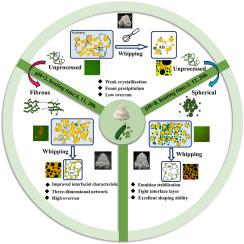豌豆分离蛋白聚集体对椰子二酰基甘油基鲜奶油的影响:界面和网络稳定机制
IF 11
1区 农林科学
Q1 CHEMISTRY, APPLIED
引用次数: 0
摘要
在控制pH和加热条件下制备了纤维状(PPIA-2)和球形(PPIA-8)豌豆分离蛋白聚集体,并对其对椰二酰基甘油(CO-DAG)生奶油的影响进行了系统评价。与传统的三酰基甘油CO相相比,CO - dag降低了界面能垒,促进了界面结晶,有利于蛋白质吸附。纤维聚集体表现出增强的界面活性和较强的分子间缠结能力,有利于脂肪球之间的桥接,促进部分聚并。PPIA-2-12h与CO-DAG之间的协同作用导致了高溢出(200 - 250%)和优异的泡沫稳定性。2 h形成的球形聚集体(PPIA-8)界面活性较弱,但可以形成致密的小脂肪球,从而提高泡沫的流变性能。CO-DAG和具有不同形态的蛋白质聚集体的共同影响决定了泡沫性和稳定性之间的平衡。该研究阐明了聚集体形态如何通过增强界面膜和创建三维网络结构来稳定泡沫。这些发现为设计植物性低脂鲜奶油提供了理论和技术框架,强调了DAG作为共结构脂质和蛋白质聚集体作为形态依赖的稳定剂的双重作用。本文章由计算机程序翻译,如有差异,请以英文原文为准。

Effect of pea protein isolate aggregates on coconut diacylglycerol-based whipping cream: Interfacial and network stabilization mechanisms
Fibrous (PPIA–2) and spherical (PPIA–8) pea protein isolate aggregates were prepared under controlled pH and heating conditions, and their influence on coconut diacylglycerol (CO–DAG)–based whipping cream were systematically evaluated. Compared with conventional triacylglycerol CO phases, CO–DAG reduced the interfacial energy barrier, promoted interfacial crystallization, and was favorable for protein adsorption. Fibrous aggregates exhibited enhanced interfacial activity and strong intermolecular entanglement ability, which facilitated bridging between fat globules and promoted partial coalescence. The synergistic effect between PPIA–2–12h and CO–DAG led to high overrun (200–250 %) and excellent foam stability. Spherical aggregates (PPIA–8) formed at 2 h exhibited weaker interfacial activity but could increase the rheological properties of foam by forming densely packed small fat globules. The combined influence of CO–DAG and protein aggregates with distinct morphologies defines the balance between foamability and stability. The study elucidated how aggregate morphology stabilizes foam by enhancing interfacial membranes and creating a three–dimensional network structure. These findings provide a theoretical and technical framework for designing plant-based low–fat whipping cream, emphasizing the dual role of DAG as a co–structuring lipid and protein aggregates as morphology–dependent stabilizers.
求助全文
通过发布文献求助,成功后即可免费获取论文全文。
去求助
来源期刊

Food Hydrocolloids
工程技术-食品科技
CiteScore
19.90
自引率
14.00%
发文量
871
审稿时长
37 days
期刊介绍:
Food Hydrocolloids publishes original and innovative research focused on the characterization, functional properties, and applications of hydrocolloid materials used in food products. These hydrocolloids, defined as polysaccharides and proteins of commercial importance, are added to control aspects such as texture, stability, rheology, and sensory properties. The research's primary emphasis should be on the hydrocolloids themselves, with thorough descriptions of their source, nature, and physicochemical characteristics. Manuscripts are expected to clearly outline specific aims and objectives, include a fundamental discussion of research findings at the molecular level, and address the significance of the results. Studies on hydrocolloids in complex formulations should concentrate on their overall properties and mechanisms of action, while simple formulation development studies may not be considered for publication.
The main areas of interest are:
-Chemical and physicochemical characterisation
Thermal properties including glass transitions and conformational changes-
Rheological properties including viscosity, viscoelastic properties and gelation behaviour-
The influence on organoleptic properties-
Interfacial properties including stabilisation of dispersions, emulsions and foams-
Film forming properties with application to edible films and active packaging-
Encapsulation and controlled release of active compounds-
The influence on health including their role as dietary fibre-
Manipulation of hydrocolloid structure and functionality through chemical, biochemical and physical processes-
New hydrocolloids and hydrocolloid sources of commercial potential.
The Journal also publishes Review articles that provide an overview of the latest developments in topics of specific interest to researchers in this field of activity.
 求助内容:
求助内容: 应助结果提醒方式:
应助结果提醒方式:


